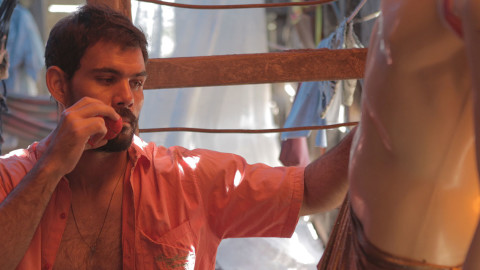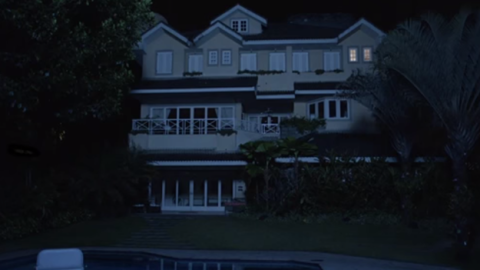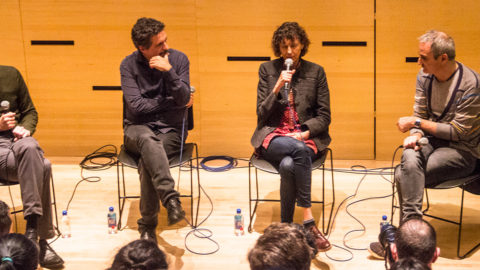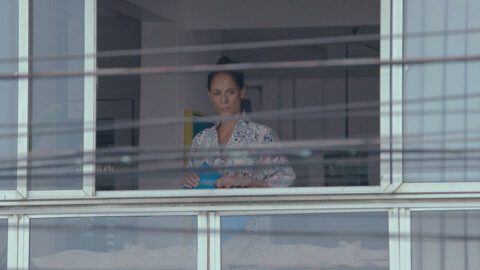Interview: Davi Pretto
To create his provocative new film Rifle, Brazilian filmmaker Davi Pretto looked as much to his country’s past as to personal experience. A slow-burning meditation on cultural subjugation and the strain of personal and political history on one man’s damaged psyche, the film employs techniques familiar to nonfiction filmmaking to a narrative of metaphysical consequence. Newly returned to a small village in South Brazil, the enigmatic Dione (Dione Avila de Oliveira) toils away his days in the local shepherding community, a vocation and way of life threatened by the encroaching influence of big city corporations. Against this expansive backdrop (shot in splendorous 2.39:1 widescreen by cinematographer Glauco Firpo), Dione moves methodically through his past, reconnecting with family and friends in an attempt to reconcile his memories with the shape-shifting spirit of a landscape he once knew so intimately. When he takes up a firearm to physically and psychologically confront this volatile environment, the film appears set to embark down a familiar road of violent recompense. Instead, Pretto gradually reveals Dione’s motivations and temperament to be the result of unseen forces, his troubled past coming inexorably to bear on the present with grave results.
Part and parcel of a new movement of Brazilian filmmakers (see Aquarius’ Kleber Mendonça Filho, Neon Bull’s Gabriel Mascaro, and Júlia Murat, director of Pendular) working to reconcile repercussions of their country’s checkered history within diverse sociopolitical milieus, Pretto is distinctly invested in the plight of the working class. As in Pretto’s prior film, Castanha, a documentary doubling as performative fantasy, the director utilizes real people and real historical circumstances to craft a film whose fluid nature and stylistic economy leaves the particulars of its protagonist’s plight an engaging, ever-evolving mystery.
Following its premiere in the Forum section at the 67th Berlinale, Pretto sat down with Film Comment to discuss the historical and socioeconomic particulars behind Rifle, and how an unrelated trip to a remote region of his home country inspired a fictional parable and a rare alternate history of a beleaguered state.
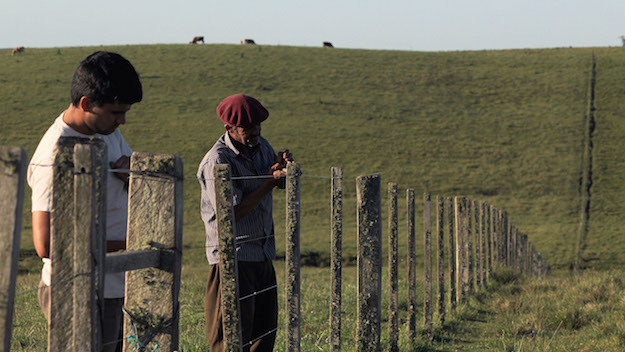
Rifle
Tell me about the area of Brazil where you shot the film.
We shot in Vacaíqua, a very small village in the southern area of Brazil, near Rio Grande Do Sul, the state where I live. It’s a region on the border of Uruguay, one very important to the history of the state. Two hundred years ago it was part of one of the biggest conflicts in the history of Brazil. So it’s a region that’s important for the history of the state and for the conflict and the situations that are happening there right now.
How familiar were you with the shepherding profession?
I’m actually from Porto Alegre, the capitol of the state. But Richard Tavares, the co-writer of the film, was born in the countryside—not exactly in Vacaíqua, but nearby, and where he lives has these same kinds of landscapes. For us the writing process included a very long research period, as it was important to not only get in touch with the people who live there, but also to find the stories and all the different things we were trying to add into the script—not only stories, but also feelings. I live in a different part of the state, but all the things that happened there in the past—and are still happening there—are things that [our community] talk about all the time. Because these are things that are important to us and represent a lot to us.
How did the collaboration with Richard begin? What was the initial idea for the film?
Richard invited me six years ago to the region, where we were traveling and working together on another project. But while we were there we started to see these little houses off in the fields, and we started to talk about them and this region and the history of this region. And then a few months later he came to me with a short story [inspired by these conversations], which provided the very first ideas for the film. The short story already had the main structure you see in the script, this ruptured structure in two parts, with the first part in the house and the second part in the roads and in the fields. But basically it amounted to four or five years of writing, working on it at home but at the same time going to the region to mix the things from the short story with the things we discovered and the people that we met as we explored the area. So it turned out to be a huge mixture of things, but the main structure came from the short story.
One of the main subjects in the corporatization of labor and the encroachment of big business, and feels fairly political as a result. Is this a topic you’re particularly invested in?
Yes, particularly because these are things that have been happening in the region for almost 300 years. The region was built when Brazil was still an empire, and this land was given by the empire to their rich landowners, so this situation was constituted from the very beginning of our state. So those in the region with very little land have been resisting for a long time. But, I should say, these things that I’m telling you are not in the history books. The part of this story that they tell in the history books is completely different [than the reality]. So it’s very naive to think that the rich landowners are very nice to the people, or that they were ever fighting to help the people against the government. So for us one of the goals of this project was to present another side to history—an objective side—and to show something different and to share something that people from that region really feel.
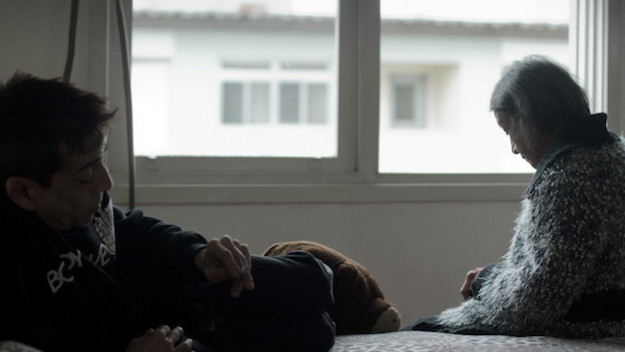
Castanha
Your prior film, Castanha, was more of a nonfiction film with fictionalized elements. Rifle is more of a narrative film with nonfiction elements. How did the approach to each film differ?
Both films were actually written at the same time. I began working on Rifle in 2010, and it was 2012 when I began Castanha. So the process was simultaneous. So for me I was trying to play with similar ideas but with different approaches for each project. Castanha was more like a dance, like you’re moving to both sides through the film’s reality and its fantasy. In Rifle the line is more clear. But my intention with both projects was essentially the same, to play with cinematic codes and genres, and also to play with this line between fantasy and reality. My intention was not to be clear in what was documentary and what was fiction, but to mix both of these things and to create something different from these various codes and genres.
How did you cast the film? Are these nonprofessional actors?
My first idea for the film was to find a real family. But it was very complicated, mostly because a lot of the young people leave this region for the city at a very young age because there aren’t schools there. And also if they want a job they need to go to the city to find one since there aren’t too many opportunities in the countryside. But I ended up finding Dione and the family toward the very end of the research and casting process. They had no experience with acting, or cameras—and actually Dione and the family only went to the cinema for the first time ever to see this movie! In the history of Brazilian cinema—or at least the films that have been shot in my state—all the actors have come from either Porto Alegre or São Paulo. This is another political aspect to the film: we were trying to create a film with the people from this region, to be able to share their stories with them, and not bring in famous actors [to tell their stories]. It was important to make this connection and hopefully make us feel to them like we’re part of a family, or a true friendship. We wanted to create an environment where they could feel confident and be part of the production.
But as far as the process, with Castanha I hadn’t done any kind of rehearsals. This time the idea was to talk a lot about the script with the actors and to create an atmosphere where they could not only understand the story, but appropriate the story. So when we shot the film they knew the scenes but they weren’t just repeating the dialogue that I brought to them. Sometimes they were doing some improvisations, or bringing something to the scenes that they thought [might work]. So it was a two-sided process—things were changing.
There are a couple of strange moments in the film, particularly the image of the burning truck and the mentally handicapped man on the roadside, that don’t seem to correlate with the progression of the narrative and feel more like premonitions, or manifestations of the main character’s psyche. How did you come to these images?
Actually the handicapped guy in the USA t-shirt came from something I saw while researching. It’s not the actual guy in the movie wearing this t-shirt, but I did see a guy on the road with a mental disorder. And as it turns out, when speaking about him with a woman I had met, I learned that he was actually her brother, and every day he would walk around alone like this. So this is where the main idea for that scene came from. But my intention with the more abstract scenes was to create and in some way express the things that you feel when you’re in this region. Because in this frontier, which evokes a kind of mystery, the fear and the enemy is always present, but you can’t exactly see any of this. So the idea was to re-create this kind of unrealistic sense of place. The sequence with the burning car was something that we heard about but didn’t see. During the research process we spoke with many people who described strange things that they’ve seen at night, like a circle of fire in the fields—weird stuff. I quickly realized that this is a region where people are more open to feel and to see different things, whether they exist or not. So we were trying to create this same sense cinematically and share it with the audience, that something else could exist out there.
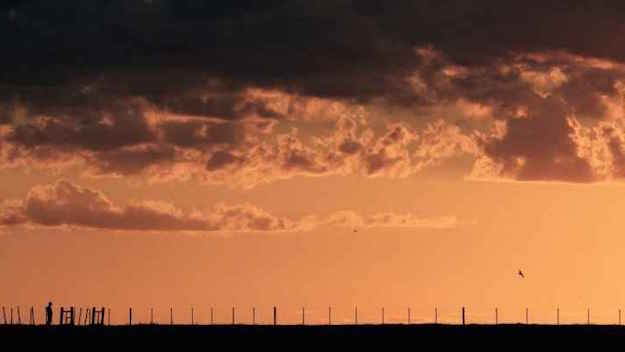
Rifle
Being a young filmmaker, one can help but trace influences. Were you looking to certain filmmakers or genres? Lisandro Alonso came to mind.
During the actual production of the film what I was watching was Westerns. Not specifically as a visual reference, but since I was researching all these topics and subjects, I realized many of them had aspects of western myths. So I started to re-watch all these Westerns from the ’30s and ’40s, all the way up through the ’60s. But of course there are also some working filmmakers I find interesting. Maybe not so much Lisandro Alonso, but certainly Pedro Costa or Apichatpong.
The movie keeps revealing bits of information along the way that seem to intended to reorient how we think about the character’s actions. How did you come to this structure?
Well, from the beginning the idea was to create a film that you can feel as the character, as if you are the character. And because our memories, as people, are fragmented, the character should also—and at the same time as the audience—be discovering this world. He doesn’t remember things beyond the film—he can’t remember his past. He’s discovering and rediscovering things along the way. For example, when he finds the book with the girl’s phone number, we’re discovering this along with the character. It was an attempt to bring this fragmented past into the present—to discover from scene to scene.
Jordan Cronk is a Los Angeles–based critic and programmer and contributor to Cinema Scope, Sight & Sound, Cineaste, Reverse Shot, and The Los Angeles Review of Books.



